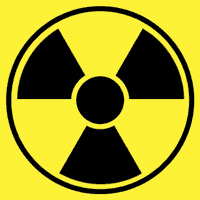
 Physicians usually weigh risks and benefits when they expose patients to radioactivity through x-rays, CT scans and radioisotopes but recently even they were shocked to find out that the low levels used to examine the arteries of the heart increased the risk of cancer.
Physicians usually weigh risks and benefits when they expose patients to radioactivity through x-rays, CT scans and radioisotopes but recently even they were shocked to find out that the low levels used to examine the arteries of the heart increased the risk of cancer.Industry and government repeat the mantra that there is “no immediate risk to human health”. Physicians for Global Survival agrees that there is no immediate danger to individual health or life from radioactivity unless the amount is enormous or prolonged.
Humans are constantly exposed to natural radioactivity from the sun, radon in the air, and naturally occurring radioactive ions such as carbon-14. People mostly don’t get cancer, auto-immune diseases such as lupus and rosacea or have miscarriages or children with birth defects. There is no doubt in the minds of medical experts, however, that increasing the global burden of radioactivity will increase the incidence of cancer.
What is happening in Japan is happening to our biosphere because wind and water travel the globe. There is a complex soup of elements released by the damaged nuclear power reactors but three are of particular concern.
Tritium, a gas, enters the environment around most nuclear power plants by planned releases or in accidents. Tritium is bound with oxygen in water which makes it extremely dangerous. Living organisms cannot distinguish between radioactive water and normal water and will absorb the radioactive water to use as biological building blocks, enzymes and genetic material. Tritium has a half-life of twelve years which means that 2 tonnes released to the atmosphere becomes 1 tonne after 12 years.
Iodine-131 has a half-life of eight days releasing beta and gamma radiation in its decay. One of the risks of treatment of cancer of thyroid with this isotope is an increase of other cancers. It is especially toxic to children and fetuses because it targets the normal thyroid in growing animals. The damage to the thyroid can be mitigated by taking potassium iodide but there is no protection for the full body gamma radiation effects.
Cesium-137 is unarguably the biggest threat. Cells treat it like potassium, allowing it to literally bathe every cell in the body and concentrate it in soft tissues, muscles and bones. Double threat cesium-137 decays by beta emission to barium-137m which emits gamma radiation before becoming stable barium 137. It can affect enzymes and DNA, disrupt normal cellular function, affect germ cells and increase the risk of cancer. The United States Environmental Protection Agency says that once dispersed in the environment, cesium-137 “is impossible to avoid”. It has a half-life of 30 years.
Physicians for Global Survival and its parent body, International Physicians for Prevention of Nuclear War, have taken the position that nuclear power cannot be made safe enough to risk the health of this planet. Dispersal of background radiation will inevitably affect human health, and the health of succeeding generations. “No immediate danger” is a short-sighted perspective.

Be the first to comment